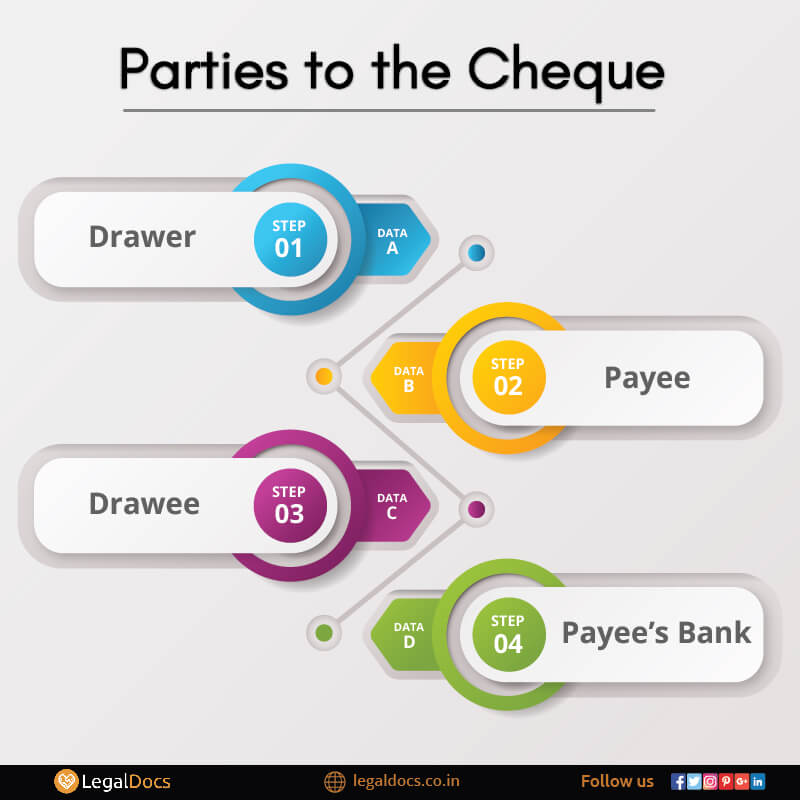3-step Easy process to send Notice under section 138 to the Defaulting Debtor (Drawer):
Login to our website and visit to the Form for Draft of Cheque Bounce Notice (under Section 138 of Negotiable Instrument Act)
Fill in the details of unpaid Creditor (Payee), defaulting Debtor (Drawer), Details of bounced Cheque, Bank detail and few other questions.
Our well-versed lawyers will work on drafting the Notice for you and the draft of Notice having all the required details will be ready for you to send.
You will get this document in an editable format so you can always edit the Notice as per your requirement.
Cheque Bounce Notice
This Notice is a Notice which shall be given by the unpaid Creditor (Payee) to the defaulting Debtor (Drawer) through an Advocate in case of dishonour of Cheque under section 138 of Negotiable Instrument Act.
The Notice here is a sample Legal Notice issued by the Advocate of the Payee specifying a 15 days time given to the Drawer in fault to pay the unpaid Cheque amount. It further specifies that if the amount is not paid within 15 days from the receipt of the Notice, the unpaid Payee has right to file legal complaint and initiate Legal Proceeding against the defaulting Drawer.
All About Cheque Bounce/Dishonoured Cheque
Parties to the Cheque:
1. Drawer : The person who issues the cheque i.e ‘author of the cheque’ is called as
Drawee. (Drawer could be the Debtor)
2. Payee : The person to whom the amount mentioned in cheque is payable i.e the
person in whose favour the cheque is drawn is called as Payee. (Payee could be the Creditor)
3. Drawee : The Bank where the Drawer has an account from which the cheque amount
shall be paid i.e the bank who is directed to pay the amount is called as Drawee.
4. Payee’s Bank : The Bank where the Payee has a bank account in which the cheque
amount shall be deposited/credited (especially in case of crossed cheque) or the bank in which payee
deposits the cheque is called as ‘Payee’s Banker’

What is meant by Cheque Bounce or Dishonoured Cheque?
Occurring of following event step by step amounts to Cheque Bounce or Dishonour of Cheque:
1. A Drawer is liable to pay some amount to the Payee and thus draws a Cheque in name of the Payee.
2. The Payee/Holder of the Cheque then deposits this Cheque in the bank where he holds an account
or otherwise. The Cheque shall be deposited on or after the date specified on the Cheque but shall not
be deposited later than 30 days from the date mentioned on the Cheque, as it becomes
invalid.
3. After depositing the Cheque in the account, if the Drawee finds it not possible to pay off the
amount specified in the Cheque, it send the ‘Cheque Return Memo’ to the Payee’s banker. Payee’s banker
then forwards such ‘Cheque Return Memo’ to the Payee informing him that the Cheque is Dishonoured.
Thus, an incapacity of the Drawer to pay off the Cheque amount to the Payee on the due date or when submitted/deposited, is called as dishonour of Cheque.
How do you come to know that the cheque is bounced?
If the Drawee Bank finds out that it is not possible to pay off the Cheque amount to the Payee due to any reason, the Drawee Bank immediately issues a ‘Cheque Return Memo’ to the banker of the Payee mentioning the reason for non-payment. The Payee’s banker then gives the dishonoured cheque and the memo to the Payee.
Cheque Bounce Reasons:
The reason for cheque bounce could be many but the one covered under section 138 of Negotiable Instrument Act, against which you can send the Notice given on our website to the defaulting debtor (Drawer) is for ‘Insufficient Balance’ in the Drawer’s account at the time of honor of cheque.
Resubmission of the dishonoured Cheque:
If the payee or a person holding the cheque believes that the cheque, once dishonoured, will be honoured the second time, he can resubmit such cheque within 3 (three) months of the date specified on the cheque.
Even then, if the drawer fails to make a payment and the cheque is found to be dishonoured, the payee has a legal right to raise a complaint against the drawer and initiate prosecution against such drawer.
Step by Step procedure for prosecution in case of Cheque Bounce:
Following is the procedure for prosecution in case of dishonour of cheque:
1. Firstly, after dishonour of cheque, a chance shall be given to the drawer in a form of written
notice to immediately repay the cheque amount. You can find this Notice on our
website - LegalDocs.co.in
2. Such Notice shall be sent within 30 days of receipt of ‘Cheque Return Memo’
from the banker of the Payee.
3. Notice period of 15 days shall be specified in such notice sent to the Drawer.
4. No offence is presumed to be committed by the Drawer if the Drawer pays off the complete amount
within the said notice period of 15 days.
5. If not, the Payee may choose to file a complaint in the competent court against such defaulting
Drawee.
6. Such complaint shall be made within one month from the expiry of 15 days
prescribed in the notice.
Conditions necessary to prosecute the defaulting Drawer:
The Drawer can be sued only in the following conditions:- If the cheque drawn by the Drawer is on the account maintained by or in the name of the Drawer himself.
- If the cheque was dishonoured and returned due to ‘Insufficient funds’ in the Drawer's account.
- If the amount mentioned in the cheque is for the discharge of some debt or liability of the Drawer towards the Payee.
- If the Drawer fails to make payment of the dishonoured cheque within 15 days from the date of receiving the written notice in this regard.
Only if all the abovementioned conditions exist, the Drawer can be sued or prosecuted for dishonouring of the Cheque.
Where can a Cheque Bounce case be filed?
who deals with Cheque Dishonour complaint/cases: (Judicial Body)
Cheque Bounce is governed under section 138 of the Negotiable Instrument Act. Any offence against Cheque, as specified under section 138 of Negotiable Instrument Act, is a Criminal Offence and thus the proceedings against such Cheque is dealt in accordance with the Summary Trial provisions of Code of Criminal Procedure, 1973 (CrPC).
The offence relating to Cheque is tried by Metropolitan Magistrate (in case of Metropolitan cities) or Judicial Magistrate of First Class (for other than Metropolitan cities). Thus, the complaint against the defaulting Drawer shall be made accordingly.
Where can a Cheque Bounce case be filed?
As per the latest change made as per 2015 Ordinance and laws for time being in force, the complaint of
the dishonour of cheque is made at the place as specified below:
1. In case where the Cheque is deposited by the Payee/Holder for collection of the amount through
his bank account - the place where the branch of the bank is situated in which the Payee/Holder holds
and maintains the account.
2. In case where the Cheque is deposited by Payee/Holder for collection of the amount otherwise
through his bank account - the place where the branch of the Drawee bank is situated where Drawer holds
and maintains the account.
Who can file a cheque bounce case?
The complaint or case of the dishonour of cheque is filed at a place where the cheque was submitted for honouring, thus, the Drawer is the one who files a cheque bounce case. The case for the dishonour of cheque can be filed not only against the individual but also against any organisation dishonouring the Cheque.Cheque Bounce Charges or Cheque Bounce Penalty:
Section 138 of Negotiable Instrument Act deals with Cheque bounce punishment. Dishonour of Cheque is a Criminal Offence which is punished with fine or imprisonment or both. The monetary penalty for dishonour of cheque may be twice the amount of the cheque. If imprisonment is pronounced to the drawer, it may extend to two years. In addition to this, the bank has right to stop the cheque book facility and close the account for repeat offences of bounced cheques.Can a person dishonouring the Cheque get Bail in case a complaint is filed?
Dishonour of Cheque is a bailable offence, implies, one can get bail if complaint is made against him for dishonouring the Cheque. But, in case where after getting bail a person fails to appear before the court after receiving summons (a letter requiring a person to be present in the court on the specified date), the court can issue non-bailable warrant against you. In effect of such warrant, the police can arrest you.Background of Cheque and its impact on Trade and Commerce
When Trade and Commerce grew and eventually started to have its strong footing in the day to day life of people, various types of Negotiable Instrument were developed with time to make the transfer of money more definite and convenient than before. People used to promise verbally to pay the due money on the later date but used to step back from their verbal promises to pay or used to stretch the date further and further when the promised due date used to come. Thus, the idea of a Negotiable Instrument was developed. Negotiable Instrument is the document, and not the actual money, which includes a ‘promise to pay’ a specific amount of money to the person bearing such a document. Cheque is one the Negotiable Instruments which became highly trusted and most commonly used mode of payment with increasing development in Banking Sector from time to time. But, as they say, ‘everything has its pros & cons’ and so, even Cheque was not left untouched!
As the process goes, a person bearing the Cheque deposits the cheque in the bank on or after the date specified on the Cheque (not later than 30 days from the date specified on the Cheque), and after a few days of a formal procedure the designated bank account of the bearer of the cheque is credited with the amount specified on the Cheque. But, with time, dishonouring of Cheques due to some of the other reason became a chronic trend and the ‘CONs’ of Cheque became more pronounced. That’s how Cheques started losing their credibility.
Earlier, the offending acts against the dishonoured cheque used to be tried in the Civil Court. The legislature thought it fit to protect honest drawers from unnecessary harassment.
But it prooved to be highly time-consuming process thus defeated the very purpose of Cheque ‘a speedy vehicle of commerce’.
As an effect, Section 138 and few other relevant sections of the Negotiable Instruments Act, 1988, governing ‘Cheque’, was amended aiming at speedy disposal of cases relating to dishonour of cheque. Even the Punishment for dishonour of cheque which was 1 year earlier was enhanced to 2 years.
The aim of these amendments was to boost the usage of cheque and reinforce the credibility of it so that the day to day transactions of trade and commerce is assured.
Current Account Opening
A current account is a type of deposit account that helps the professionals and businessmen to run their business. Businessmen can avail various benefits by Online Current Account such as:
- Unlimited transactions
- Customized features
- Online banking services
Online current account reduces the hassle and provides the benefit to complete the banking process anytime and anywhere.
Are you Ready to Grow your Business?
- Zero Balance Current Account
- In just 5 mins
- Free Current Account Powered by ICICI Bank
Cheque Bounce FAQs
What is section 138 for Cheque Bouncing?
How do I send a Cheque Bounce Notice?
1. Date , Month and Year.
2. Cheque issuer name
3. Address
4. City, State, Pin Code
5. Letter body with details of
-> Goods and Services
-> Delivery date
-> Cheque number
-> Cheque date
-> Cheque bank name
-> Returning memo number
-> Cheque return
-> Cheque amount
-> Cheque payee name and address
Cheque bounce notice or Section 138 notice can be easily created using the IndiaFilings Live Edit feature. Once the document is created, it can be printed on a plain white paper or letterhead of the business and delivered to the cheque issuer. The cheque bounce notice must contain the name of the cheque beneficiary, check issuer name and address, date of return of cheque, reason for return of cheque, request to make arrangements for alternate payment immediate and the words that the notice is issued under Section 138 of the Negotiable Instrument Act. It is important to send the Cheque Bounce notice through registered post, so that the date of issuing notice can be recorded formally. One copy of the letter can be retained by the cheque’s beneficiary while the other copy is delivered to the cheque issuer through registered post.
What is the Penalty for Cheque Bounce?
Why is Cheque issued?
That’s the reason why Cheque is a highly trusted and most commonly used mode of payment in day to day trade and commerce.
What is Section 138?
What is 'Cheque Return Memo'?
Can Payee resubmit the dishonoured cheque to the bank?
What is the Punishment under Indian Law for dishonouring the cheque?
After dishonour of the Cheque, can the Drawer get another chance to honour the same cheque?
You can find this Notice on our website - LegalDocs.co.in
Notice period of 15 days shall be specified in such notice sent to the Drawer. No offence is presumed to be committed by the Drawer if the Drawer pays off the complete amount within the said notice period of 15 days.
What is a Legal Procedure to take action against the defaulting Drawer?
Where to file the complaint against the defaulting Drawer?
2. In case where the Cheque is deposited by Payee/Holder for collection of the amount otherwise through his bank account - the complaint against the defaulting Drawer shall be filed at the place where the branch of the Drawee bank is situated where Drawer holds and maintains the account.
 Knowledge Center
Knowledge Center























